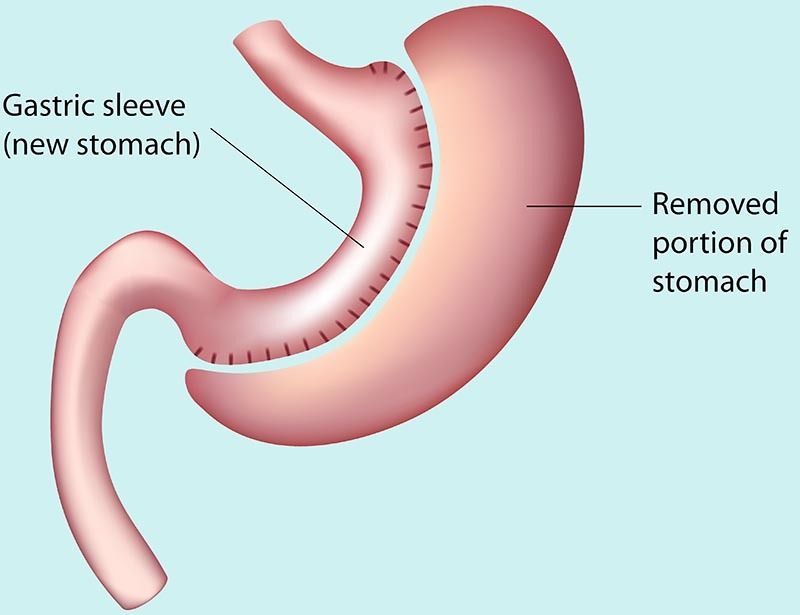Gastric Sleeve Surgery is a weight loss procedure in which a large part of the stomach is surgically removed, reducing the stomach size by up to 85%, with the remaining portion of the stomach looking like a banana or a sleeve. Given the severely reduced stomach size, patients are unable to consume and digest as much food before quashing their hunger and feeling full – as a result, rapid weight loss can be achieved. This type of surgery is non-reversible and should only be considered as a final option.
A person is termed obese if their body mass index (BMI) is greater than 40 and their weight is 100 lbs / 50 kg more than their ideal weight. For these people, Bariatric Surgery is an available option. There are many associated risks concerned with Obesity that can lead to hypertension, infertility, diabetes, sleep apnea, and much more. When methods, such as dieting and exercising do not work, a Gastric Sleeve procedure can be the final solution, but not everyone is a good candidate and each individual should carefully consider the best options available to them, considering present condition, health history, cost, recovery time, success rate and pros and cons of the surgery. Alternatively, a Gastric Balloon may be preferred instead – see below for more information on this non-invasive procedure.

The Procedure
Contents
Surgery is performed under general anesthesia using a laparoscope, with several small incisions being made on the belly, a tube fitted with a camera (laparoscope) is then inserted through these incisions to give a clear picture of the insides. The surgeon will view these images, before beginning the process of surgically removing up to 85% of the stomach’s volume using specialist surgical instruments. The remaining stomach pouch now resembles a dramatically reduced sleeve or banana. All the instruments are removed and the incisions are stitched and bandages applied to the wounds.
Length of Stay in Destination
Gastric sleeve surgery is an inpatient procedure that lasts about one hour in the operation theatre. After this, you are moved to a recovery room where your vitals are monitored. A two to three days hospital stay is required after surgery and you are discharged when your condition is stable. You should stay local for at least 7-8 days for follow up check-ups. During this period, you are kept under review and the stitches are removed after 5 to 7 days.
Recovery Time
It will take two to three months to get back to normal meals and the amount of food you will eat is considerably decreased. You will likely suffer from a swollen and sore stomach for several days, with medicines being prescribed to help deal with the pain during this period. After two to four weeks, you can return to some normal activities, however, on average, six weeks of rest is required. As it is laparoscopic surgery, less time is required to recover and scars are small which fade away over time.
Aftercare
The following are some points to consider after leaving the hospital:
- Intake only liquids for the first two to three days. After this, you can start taking pureed food and shakes. You will have to continue with this for at least 4 weeks. After which you can start eating solid food items. Do not eat very heavy food items. Avoid drinking water with food, as it fills your small stomach immediately.
- Follow a proper diet plan as you will have to fulfill your nutritional requirements with a smaller amount of food.
- Take multivitamins and minerals daily. Especially vitamin B12, as pernicious anemia needs to be prevented.
- Do not climb up the stairs, also, do not bend. Avoid those activities which can put stress on your abdomen.
- Change your bandage regularly and do not let it get wet as this can cause infection.
- Ensure you have regular check-ups and your weight loss is recorded during these visits.
- Take your painkillers regularly to relieve yourself from the post-surgery pain.
Success Rate
You can expect to lose 60% of your excess weight within 12 to 18 months post-surgery. The Gastric Sleeve is now the most popular form of Bariatric Surgery based on the extremely high success rates seen across the world. Patients can expect a huge decrease in weight, coupled with a vast improvement in health conditions and a reduction in such diseases as diabetes.

Alternatives to Gastric Sleeve
1. Gastric Band – An inflatable silicone device is fitted around the top portion of the stomach to create a smaller stomach pouch, intended to decrease the amount of food consumed in one go.
2. Gastric Bypass – The stomach is divided into two parts; a small upper pouch and a large lower ‘remnant’ pouch. The small intestine is rearranged accordingly, bypassing the large pouch and thus significantly reducing the volume of the stomach.
3. Gastric Balloon – An inflatable device is temporarily inserted into the stomach via endoscopic placement. The balloon obstructs a sizable area of the stomach, thus reducing the amount of food it can contain at any one time.
Before and After Gastric Sleeve
Gastric sleeve surgery is a weight loss surgery. Before this surgery, you are obese and under the risk of its associated diseases. Your physical appearance will be less desirable and your activities restricted. After you go through this type of surgery, your physical appearance changes tremendously and your ability to undertake strenuous activities dramatically increases – but it will take time before you reach this stage as much weight needs to be lost first.
For an in-depth analysis of a Gastric Sleeve Procedure, watch this short video.
To check prices or to book a Gastric Sleeve Procedure in Turkey or anywhere else in the world, head on over to MyMediTravel now!

